U.S. population health faces many challenges, including stagnating and even declining life expectancy, and widening health disparities. Against this backdrop, I will discuss the role of selection in the trend of health disparities, evaluate the “Deaths of Despair” narrative, and analyze the cohort health trend. The first study addresses the dynamics of smoking initiation and cessation and how they may contribute to the widening educational gap in smoking prevalence. The second study directly investigates despair as a determinant of death and the temporal variation and racial heterogeneity therein. The third study investigates whether the increasing morbidity and mortality among middle-aged and young-old Americans since the turn of the century has been extended to younger cohorts. I explore conditions from birth to the present by investigating the nutrition, health, socioeconomic, psychological, and bio-behavioral factors throughout the life course across multiple birth cohorts. I probe both protective resources that might advantage recent cohorts and risk factors that might disadvantage recent cohorts. By doing so, we gain a preliminary but plausible account of what may or may not contribute to adverse cohort health trends, and what disadvantages may offset advantages to which recent cohorts are subjected. To wrap up, I will discuss the policy implications from these three studies.
Hui Zheng is a professor of sociology at The Ohio State University. His research focuses on social and policy determinants of health, and population process of aging and mortality. He has investigated health consequences of various social structures, institutions, and policies; the trends of socioeconomic and demographic disparities in health; trend and heterogeneity in aging, mortality, and life span; the impact of life course dynamics of obesity on mortality; and the role of selection in the health production and aging process. Current projects investigate the rising health challenges in the U.S.; cohort and life course dynamics of cognitive aging; nativity disparities in labor market, aging, and health; and workplace, work, and health disparities. His work is supported by grants from CDC (National Center for Health Statistics) and NIH (NIA, NICHD) and published in internationally high-visibility and high-quality journals, including American Sociological Review, Demography, American Journal of Epidemiology, Journal of Health and Social Behavior, Social Science and Medicine, and American Journal of Public Health.
Remarks
- ZOOM link will be sent via email, for HKUST members ONLY
- Please use your HKUST ITSC account to join the zoom meeting.
- This meeting is being recorded. By joining, you are giving consent for this meeting to be recorded.

